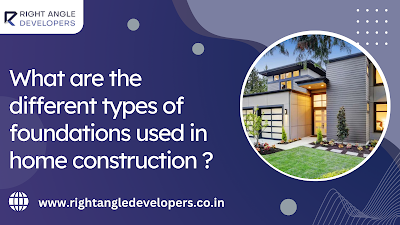What are the different types of foundations used in home construction ?
Introduction:
Constructing a home is equivalent to creating a dream from the ground up. The foundation is the most critical aspect of laying the groundwork for your dream home. It not only supports the structure but also ensures its durability and stability for years to come. Therefore, let's delve into the world of foundations and explore the different types used in home construction.
Concrete Slab Foundation:
Many homeowners choose a concrete slab foundation due to its simplicity and cost-effectiveness. This foundation involves pouring a thick layer of concrete directly onto the leveled ground, providing a solid base for the structure above. Concrete slab foundations are ideal for regions with stable soil conditions and mild climates. They have several benefits, including quick installation, minimal excavation, and the ability to incorporate radiant heating systems. Additionally, concrete slab foundations can be strengthened with steel bars to enhance their strength and durability, making them suitable for supporting both single-story and multi-story homes.
Crawlspace Foundation:
A crawlspace foundation is advantageous in areas with high humidity levels or uneven terrain. This foundation elevates the home slightly above the ground, creating a small space, or "crawl space," underneath. Crawlspace foundations provide easy access to plumbing, electrical, and HVAC systems, making maintenance and repairs more manageable. They also help prevent moisture-related issues, such as mold and mildew, by promoting airflow and ventilation. Additionally, crawlspace foundations can be insulated to improve energy efficiency and comfort within the home.
Basement Foundation:
A basement foundation adds valuable living space and storage options to a home while providing additional structural support. This foundation involves excavating below the ground level to create a full or partial basement. Basements offer numerous benefits, including extra square footage for recreation rooms, home theaters, or guest bedrooms. They also protect against severe weather events, serving as a safe shelter during storms or tornadoes. Basement foundations can be finished with insulation, drywall, and flooring to create comfortable living areas that enhance the overall value and functionality of the home.
Pile Foundation:
A pile foundation is often the best choice for areas with challenging soil conditions, such as sandy or marshy terrain. This foundation utilizes long, slender piles driven deep into the ground to support the structure above. Pile foundations distribute the weight of the building evenly, reducing the risk of settlement or subsidence. They are commonly used in coastal regions and areas with high water tables, where traditional foundation methods may be inadequate. Pile foundations can be constructed using various materials, including concrete, steel, or timber, depending on the specific requirements of the project.
T-shaped Foundation:
A T-shaped foundation is designed to provide additional support and stability in areas with expansive soil or heavy loads. This foundation features a wider footing at the base, extending below the frost line to prevent frost heave. The stem of the T shape supports the walls of the structure above, distributing the load evenly and minimizing the risk of settling. T-shaped foundations are commonly used in colder climates and regions with clayey soil, where frost action and soil movement can pose significant challenges to traditional foundation systems.
Raft Foundation:
A raft foundation, also known as a mat foundation, is a massive concrete slab that extends over the entire footprint of the building. This foundation distributes the weight of the structure evenly across a wide area, reducing the risk of differential settlement. Raft foundations are particularly well-suited for areas with poor soil conditions or high seismic activity, where traditional foundation methods may be inadequate. They provide excellent stability and durability, making them a popular choice for large commercial buildings, industrial facilities, and high-rise structures.
Strip Foundation:
A strip foundation consists of continuous strips of concrete or masonry that run along the perimeter of the building. This foundation is commonly used for structures with long, narrow footprints, such as row houses or commercial buildings. Strip foundations distribute the load evenly and help prevent differential settlement, ensuring the stability and integrity of the structure above. They can be reinforced with steel bars or mesh to enhance their strength and durability, making them suitable for a wide range of building applications.
Conclusion:
The choice of foundation is crucial for the structural integrity and longevity of a home construction. By understanding the different types of foundations available and their unique characteristics, homeowners can make informed decisions that ensure their homes are built on a solid foundation.
More Information :
Call Us: +91 8088900660
Mail Us: info@rightangledevelopers.co.in
Website: https://www.rightangledevelopers.co.in/




Comments
Post a Comment